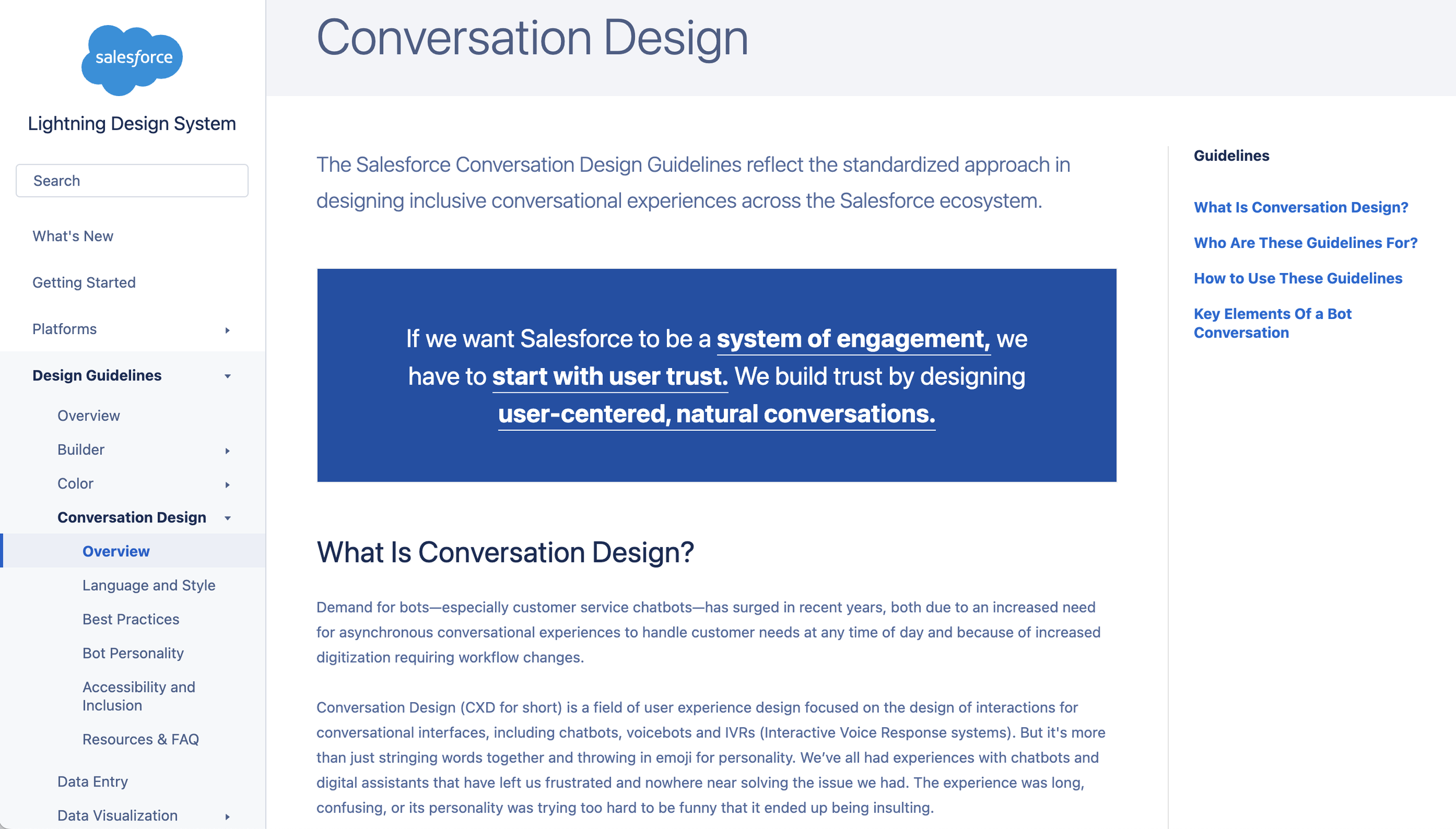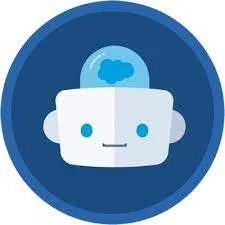Salesforce–Amplifying the Conversation Design Practice
Enterprise-level Conversation Design across customer-facing and internal bot experiences.
My role: Conversation Design Senior
Platform: Slack for Salesforce; Einstein Bot Builder
Overview
Salesforce is the world’s #1 customer relationship management (CRM) platform and one of the largest technology companies in the world. It was quite a contrast to join a company of this size after working at a startup of ten people.
I worked adjusted hours to align with the core Salesforce Conversation Design team and stakeholders based on the US West Coast (PT). (The entire Conversation Design team was distributed globally–from Hawaii, to San Francisco and LA, to Canada, Europe and Australia.)
NOTE: Many images are low-res or blurred and cannot be expanded for confidentiality purposes.
Please contact me if you would like further information.
SALESFORCE CONVERSATION DESIGN GUIDELINES
I elevated our internal Conversation Design guidelines into a polished design standard which has been published externally on the Salesforce Lightning Design System site.
Through completing this work I achieved a key milestone for the Conversation Design team, as the publishing of these guidelines was a huge step in positioning Salesforce's Conversation Design practice as a leader in Conversational AI.
The guidelines are publicly available for anyone seeking to optimize their conversational experiences.
My work involved collating, reviewing, and consolidating iterations of existing content into a structured and cohesive set of guidelines. This content included existing resources and best practices across Trailhead (Salesforce’s free online learning platform), decks, blogs, and one-pagers that had been contributed to by present and past team members. I led walkthroughs of proposed updates, coordinated feedback, and collaborated with our Design Systems UX and Design Ops teams to drive the guidelines to final sign-off, ready for handover to a developer.
I was subsequently recognised as a Salesforce "Release Rockstar" among select Experience Services team members who were considered to have gone “above and beyond", despite the fact that I’d only been with Salesforce for only a couple of months.
SLACK FOR SALESFORCE
Salesforce has several internal Slack bots with an audience of over 80,000 Salesforce employees, and functions including work-related support, task reminders, and approval requests. For example, the Concierge app is a self-service platform used by employees to find answers and log support tickets for all IT and HR-related questions and issues.
The Slack product design team approached our Director of Conversation Design for support with standardising the voice and tone of these apps. I subsequently led a voice and tone review to optimise the language experience for these internal Slack for Salesforce apps, in collaboration with some of my Conversation Design peers. I personally reviewed Concierge–the largest of the apps–and Task Hub.
Following on from our initial review, I was further engaged to provide conversational style guidance on app error messaging for Amplify, an app that helps users communicate with employees as a bot.
Concierge Case Study, created and kindly shared by Nathan Smith, Lead User Experience Designer
Amplify Case Study, created and kindly shared by
Jennifer Kong, User Experience Designer
UNIFIED CHATBOTS
As part of the cross-cloud team working on the Unified Chatbots initiative, I completed design audits of two of Salesforce's main customer-facing bots–Trailhead Help (on Salesforce’s Trailhead online learning platform) and Salesforce Easy (on Salesforce’s newly launched and simplified CRM solution). The Unified Chatbots initiative has the goal of bringing together disparate bot teams and standardising the language design and conversational experiences of their bots for Salesforce customers.
The audits involved an analysis of the existing bot content in the Einstein Bot Builder, and also required the creation of design documents so that comments and proposed updates could be collated.
The feedback presented back to the relevant bot teams covered both language design (dialogs) & conversation design (IA, structure, and best practices).
I recommended changes that would significantly improve the current conversational experience, including consistent language use, addressing error loops and repetition, streamlined interactions, and increasing the bot response delay.
SALESFORCE MARKETING CLOUD - SUPPORT BOT
Due to my contribution to Unified Bots (see above), the Digital Customer Support team engaged me to review their proposed updates for the customer-facing Support Bot for Marketing Cloud.
I first reviewed the existing Support Bot dialogs and IA in Einstein Bot Builder to familiarise myself with the current state of the Support Bot. I then reviewed the new designs and provided feedback to the team based on our Conversation Design guidelines. My recommendations covered language design and best practices, such as conciseness, consistency, tone, and general simplification of user flows.
This was all completed on a very tight timeline as the team was working towards a Q4 release, with feedback and updates required before the Christmas break.
I received positive feedback from the team, with the following response from my key stakeholder:
“Thank you for the review and feedback you have provided so far!...This type of feedback is exactly what I was looking for and will add a lot more polish to the dialogs.”
CONVERSATION DESIGN EVANGELISM
I took the opportunity to present at the Salesforce Design Town Hall for APAC and EMEA, which had a broad audience across Europe, India, Australia, New Zealand and many other countries.
I used this presentation to represent the Conversation Design team–with emphasis on our geographic diversity and the extensive work that we accomplish across numerous Salesforce Clouds.
Throughout my time at Salesforce, I also sought and reached out to people from appropriate teams in the APAC region who were working with local clients on Einstein Bot deployments. I used this both as a networking and learning opportunity for myself, but also to introduce the expertise of the Conversation Design team and help to break down any silo between US-based product-focussed teams and local customer-focussed teams.



